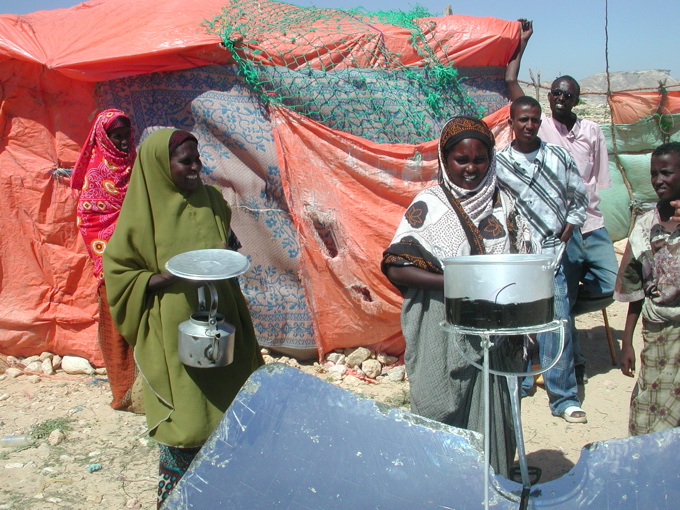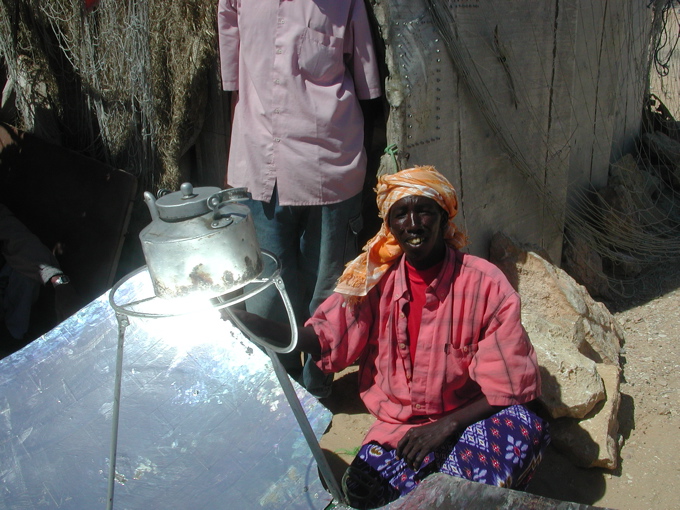Bander Beyla Leads the Way in Solar Cooking
Read some poems inspired by our work and see some more photos of Bender Bayla.
29 November 2005
Bander Beyla is an old, well-established but small and isolated fishing town on the Indian Ocean about 200 km south from the tip of the Horn of Africa. In December 2004, part of the town was destroyed by the tsunami.

Driving over dirt tracks to reach the coast, after many kilometers of flat dry land, a breathtaking view of a small bay, a town and a beach with white breakers suddenly opens up below. This is Bander Beyla, wedged between sculpted brown hills and the turquoise blue Indian Ocean with white breakers crashing onto silver sand beaches.
Sun Fire Cooking in partnership with Horn Relief and funded by the United Nations is distributing 950 solar cookers to this tsunami-affected town. Bander Beyla will be the first solar cooking village in the world and will show the way forward for many places where sun is plentiful and people rely on charcoal and wood for daily cooking.
.
.
.
.
.
.
.
.

.
.
.
.
.
.
Distributing 950 solar cookers in this remote seaside Somali village is quite a challenge. For a start, that's 50 tons of metal which has to be transported from the Port of Bosaso, 10 hours away by mostly dirt tracks. Upon arrival in Bander Beyla the parts for all the cookers, (each cooker when assembled weighs about 50 kilos), must be offloaded and then assembled by human labor power, working in the hot sun.
Working with the village elders, local officials, women and youth organizations, we have begun a survey of all families living in the town. Slowly we are making our way through every neighborhood, talking with every family about their use of charcoal and the benefits of solar cooking.

.
.
.
.
.
.
.
.
.
.
.
.
.
Every day people come to volunteer and lend their support. We have groups of enthusiastic youth eager to learn how to assemble the cookers. Some of them return day after day, eager to take on any job from assembling to painting cooking pots black.

.
.
.
.
.
.
.
We started distributing the first 100 solar cookers today. We distributed 16 the first morning.
Our training teams quickly discovered several challenges. Because many different volunteers had assembled the cookers, we discovered some of the bolts had not been properly tightened, making the holder of the cooking pot unstable.
In their homes, some people didn't realize that to have the cooking pot level, they had to have the cooker level by putting stones underneath if the ground was sandy or uneven.
.
.
.
.
.
.
.
 Other villages worried that the reflection of the sun from the cooker could damage their eyes if they didn't wear dark glasses. We reassured them that it wouldn't. Eyes instinctively close when they look at something bright. Once they learn how to adjust the cooker, it takes only a few seconds to adjust the cooker just by looking at the black bottom of the cooking pot.
Other villages worried that the reflection of the sun from the cooker could damage their eyes if they didn't wear dark glasses. We reassured them that it wouldn't. Eyes instinctively close when they look at something bright. Once they learn how to adjust the cooker, it takes only a few seconds to adjust the cooker just by looking at the black bottom of the cooking pot.
Everywhere the response was positive. Many families were able to successfully cook their lunch. Other families, because of lack of resources, said they usually only cook one meal a day, their supper.
.
.
.
.
.
.
.

Bander Beyla families, even though most have very limited income, generally spend about $30 a month on charcoal (that's four 25kg sacks), which is a huge proportion of whatever resources they have. Solar cooking should reduce their use of charcoal by 75%, giving the family more funds for other expenses.
Tomorrow we will visit every family and learn from them how they are using the solar cooker and what questions they have.
.
.
.
.
.
.
.
.
.
.
.
.
.
